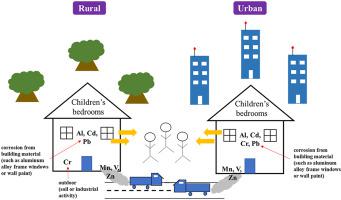Atmospheric Environment ( IF 5 ) Pub Date : 2021-08-28 , DOI: 10.1016/j.atmosenv.2021.118701 Chien-Cheng Jung , Wang , Wei-Hsiang Chang , Chung-Yu Chen

|
The objective of this study is to gain a better understanding of the metal characteristics, sources, and health risks of children's exposure to PM2.5 and related metals in children's bedrooms in urban and rural areas. PM2.5 personal environmental monitoring samplers were used to collect both indoor and outdoor PM2.5 in urban and rural areas in Taiwan. Al, Cd, Cr, Mn, Pb, V, and Zn were analyzed by inductively coupled plasma mass spectrometry. Source apportionment of metals in PM2.5 was carried out with factor analysis (FA). Health risk assessment of metals was performed on children via inhalation. The average indoor PM2.5 concentrations were 11.9 ± 5.2 μg/m3 and 11.9 ± 4.7 μg/m3 in urban and rural areas, respectively. The most predominant metal indoors in urban areas was Al, followed by Zn, Pb, Mn, V, Cr, and Cd, with a similar result in rural areas. The results from FA indicated that traffic emission and oil combustion in the outside environment were major pollution sources to indoor Mn, V, and Zn; corrosion of building material could be a contributor to Al, Cd, and Pb; pollution sources were different to Cr in two areas. The carcinogenic risk for indoor Cr(VI) via inhalation was higher in urban areas (boy: 6.61E-06; girl: 6.18E-06) than that in rural areas (boy: 2.80E-06; girl: 2.62E-06). These findings will help us to further understand the pollution sources, health risks, and control strategies for metals in PM2.5 in children's bedrooms for reducing adverse health effects, including in rural areas.


























 京公网安备 11010802027423号
京公网安备 11010802027423号